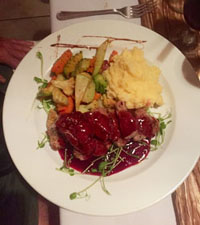|
|
|---|---|
Edition 77- January 2015 Happy New Year! |
Broken News
(All the News That's Fit to Reprint)
Budget Bloopers
The current president of Costa Rica, Luis Guillermo Solis took office in May of this year (see Solis Takes Office) promising frugality, transparency, an end to corruption and all the other things politicians love to promise. In an uncontrollable urge of enthusiasm at the same time, Solis' new finance minister, Helio Fallas, announced his intention to balance the budget (see Balanced Budget, Really?), something required by the original Costa Rican constitution to be done for each and every budget but somehow ignored by previous administrations with the help of the courts here. Fallas targeted 2016 to reach that goal.
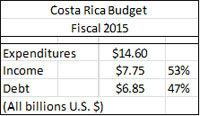 |
Well, SeñorFallas and his boss are going to have to work like the devil to attain that objective as they just submitted, and the Assembly approved 27 to 21, a budget with a 19% increase in expenditures over the previous year.
That budget amounts to an operating deficit of 47% versus the previous budget at 40% and as a percentage of Gross Domestic Product it's 6.5% versus 6% the previous year. Operating the government by expanding expenditures by nearly 20% and then borrowing nearly 50% of its operating funds doesn't seem to fit Sr. Solis' pledge of "frugality" that he made in his inaugural speech back in May. Of course, simultaneously, he's proposing an increase in taxes via the value added route which would raise sales taxes from 13% to 15%. That 2% increase (actually 15% more tax on each buy), assuming they would tax the whole GDP (which they can't by law) and assuming they collected all the tax (which they've never been able to do) would still fill only about 15% of the gap between revenues and expenditures.
I guess deficits are not important anymore and bring no negative consequences, eh? One analyst reported " That debt will have to be placed at a rate higher than the rate the previous administration borrowed", because "Costa Rica has dropped in the eyes of international debt rating agencies".
It seems the Sala IV (also known as the constitutional court) can be very accommodating. In addition to OK'ing deficit spending some years ago despite the balanced budget article in the constitution, they also agreed with the Solis premise that his new Minister of the Presidency (Chief of Staff), though currently a sitting Lutheran Bishop, does not violate the constitution's charter that says government ministers must be secular. Why not? Because he's not Catholic. How's that for a stretch?
Now that's a flexible budget and a friendly court.
The Chronicles has been following for several years now the potential construction of a new Panama Canal-like waterway across Nicaragua.
The project first came to light when Nicaragua, under its President (for life) Daniel Ortega, ordered the invasion of Isla Calero, an island at the end of the San Juan River near the Caribbean that is part of Costa Rica's sovereign territory. That was in late 2010 and the Tico complaint about the aggression has been in the World Court in the Hague ever since (what they could do about it is questionable anyway). It later came to light that the seizure would allow the Nicas to construct a new access for the canal project and the idea of building a new canal surfaced shortly after the invasion.
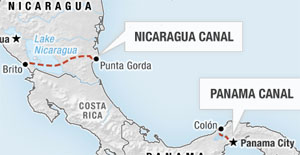 |
Latest Route for Proposed Nica Canal |
But the route for the Nicaragua project keeps changing. The latest scheme follows a long series of proposals going back 100 years when the Nicaragua route for a trans Centroamerica canal lost out to the much shorter and less costly Panama option. The new scheme ignores the mouth of the San Juan river completely.
And the cost estimate keeps increasing, the original plan was to cost $30 billion, then it went to $40 billion last year and now the powers to be are talking $50 billion. Might it more like $100 billion? My guess is that the three figure number is more likely given the hurdles yet to overcome. Environmentalists are now getting interested in the project and stirred up because a good part of the route (see map right) will be across fertile land. And beyond that there's basically no way to dig a ditch this size without making a big mess.
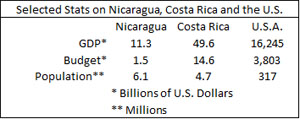 |
It helps to look at the size of this project in relation to the economy of the country. Nicaragua is a relatively poor country. Even though Nicaragua has a population 30% greater than Costa Rica, its GDP is only about 20% that of Ticoland and its national budget is only one tenth that of Costa Rica. Purportedly, Danny Ortega sees this project as lifting his country out of poverty in one fell swoop, yet one can't help but think its size and proportion would only create great distortions in the fledgling economy that is Nicaragua.
And how will they finance such an undertaking with such a small budget? They won't. The story is the Chinese will finance and build it. The latest version of that narrative mentions a Chinese billionaire, Wang Jing, who believes he can raise the $50 billion, but some think he's simply a front for the Chinese government. And why would the Chinese government put out that kind of money for a venture with a high likelihood of financial insolvency? Are they trying to buy Nicaragua? If so, the $50B is not a bad number if you use a 3-4 multiple of sales value (GDP), a ratio often used to establish a selling price on a business (3 x 11 = $33B; 4 x 11 = 44B).
Until they actually do it, GG believes the project was best summed up by a taxi driver we encountered on our last visit to Nicaragua. Said he: "I'll believe it when I see it."
And if they do do it, God help the country.
Ticos Concerned for Americans
Don't ever say the people and residents of Costa Rica are not concerned about the welfare of you northern people both in the U.S. and Canada. To prove it, take a look at the new Ministry of Tourism ad campaign about all the vacation time Norteamericanos are wasting that could be spent here. Go here:
Be sure to click on the button labeled "A SONG FROM THE ANIMALS".
Curious Tourist Department
 |
Unidentified Visitor |
GG was lounging in his usual beach chair on Manuel Antonio beach a few days before Christmas when a curious visitor took up blanket position next to him.
As unusual I started a conversation by asking where the gentleman was from. "A little north of Alaska", says he. Been to Costa Rica before? "Many times, the cutest kids in the world are here". I certainly couldn't argue with that. Plan on being here long? "No, unfortunately, I've got to go back to work tomorrow." Sorry, amigo.
He was kind of a jolly old fella; hope he comes back again.
¡Pura Vida!
Rumble Talk
(Shaky Happenings On or About the Pacific Rim)
Slumber Rumble
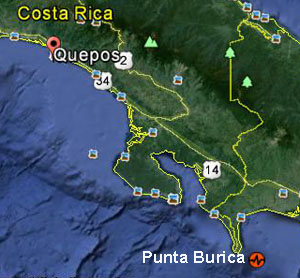 |
It was December 8, 2014, just about 3 AM and GG was tucked into his slumber lumber, dreaming about the fabulous pizza he had a week before in Buenos Aires, when he was rudely awakened by the bed gently shaking for about 10-15 seconds. Funny, he hadn't remembered putting a quarter in the bed vibrator earlier (wait, gilded one, you're thinking about a Holiday Inn decades earlier). One can be a bit groggy at 3 AM.
Later, a visit to the US Geological Survey website (see link below) would confirm that there had been a tremor off the northwest coast of Panama near a small town called Punta Burica and very near the farthest point southwest in Costa Rica. This is about 200 km (120 miles) as the macaw flies from the greater Quepos metropolitan area.
The USGS put the magnitude of the quake at 6.6 on the Richter scale, which is pretty strong, and the depth at 20 km (12 miles) which is rather shallow (recall that the giant 7.6 shaker in in the Nicoya in 2012 was 41km/25miles deep, while the Haiti monster at 7.1 in 2010 was only 13km/8 miles deep. But in Haiti, the quake was right under the capital city where very poor quake-resistant construction resulted in 200,000+ deaths.
Again, the potential damage these things can do to people and property depends on 1) how much energy is released (Richter #), 2) how close you are to the epicenter vertically and horizontally, 3) how deep it is and 4) what kind of construction prevails in the area.
| Check Out Recent Earthquakes Around the World Posted by the U.S. Geodetic Survey: Today's Quakes |
|---|
Manuel Antonio Rocks!
(The Rock Islands of Manuel Antonio Beach)
The official name of the main and longest MA beach outside the national park is Playa Espadilla but it's often referred to as Manuel Antonio Beach. GG has spent many a pleasant hour there over the past several years nestled into a lounge chair near the Mar y Sombra area.
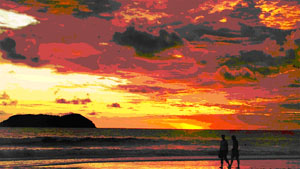 |
Manuel Antonio Beach at Sunset With Magotes Island (Elephant Island) |
The view is outstanding, sometimes breathtaking; a jungle sweeping 180 degrees behind you, an expanse of Pacific Ocean in front and sticking out a half mile or so offshore is a series of small to large rock islands dotting the horizon.
GG believes these islands act as a bit of a breakwater to initially reduce those large Pacific swells to smaller ones. This makes the surf at MA Beach somewhat more manageable for swimmers (read: less interesting for expert surfers) and probably why the surfing sperts tend to go north (Jacó - Playa Hermosa) or south (Dominical) for their thrills. For the more mature dudes like GG (age-wise that is) , the calmer the water the better.
Nota bien: This comment should not be construed as suggesting that the surf here is always safe for swimmers. There are still plenty of rip currents that appear on any given day and particularly during the rainy season when Pacific storms make the surf more agitated (GG call's it "agua enojado" or angry water). Unfortunately, we have our share of drownings periodically. So, be aware and be safe.
Then one day GG asked the question: "Do these islands have names?" The answer was not quickly forthcoming, even from some long-time locals. But two people were particularly helpful. One was Federico Ramirez, the owner of the now defunct Mar Y Sombra restaurant and nightclub, whose family moved here in 1948 to avoid the civil war then raging in Costa Rica (see History of Costa Rica - A Primer, Part III). Federico had been helpful to GG earlier in establishing the origin of the name Manuel Antonio.
A second gent who actually supplied the names of most of the islands is Peluca, our beach buddy who also supplies umbrellas and chairs to make our visits to the beach comfortable.
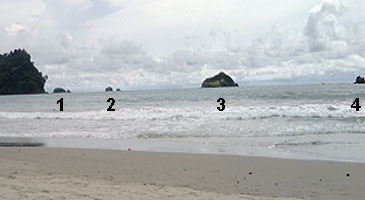 |
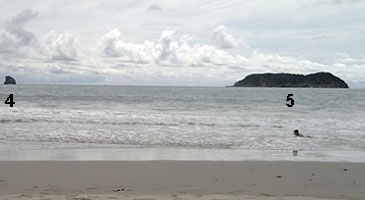 |
Composite Panorama of the Islands Just Off the Coast of Manuel Antonio Taken from the Beach. The Cliff on the Left is Punta Catedral (Cathedral Point) in the National Park, the Little Island Below (#1) is Tortuga, Next to the Right is the Un-Named Duo (#2), Then Lorocuitas (#3). In the Middle (#4) are Las Gemelas (the Twins) and Last on the Right is the Largest of All the Islands (#5), Mogotes, Also Known to Some as Isla Elefante (Elephant Island). |
|
So here's what our crack investigating reporting team learned (the numbers refer to the composite panorama above):
- The little set of two islands below the Punta Catedral cliff in Manuel Antonio Park is called Isla Tortuga or Turtle Island. Look closely and you can see the profile of a tortoise.
- The next set of two rather nondescript islands to the right are un-named at this point. The Chronicles proposes we name them Islas Pelucas after our beach buddy who we have also designated as the Alcalde de La Playa (Mayor of the beach).
- Lorocuitas is the second largest island in the group (after Magotes). This is a strange name as literally translated it means "Parrot Droppings". (See the etymology of "cuita" in the What-s-in-a-Word section below) I've never seen the island up close and it's name does not entice me to want to do so but I keep wondering if it should really be called "Gaviotacuitas" or Seagull Droppings; how did parrots get involved? Here we go again; there is no end to the need for research by the inquisitive mind. Peluca reminds us that female parrots (loras), are much more prolific talkers than the males (loros). GG's not touching that remark.
- Panning to the right after Lorocuitas, the next set of two small islands are well known by the name of Las Gemelas (The Twins). Federico tells an interesting story about Las Gemelas. He claims that when his family moved to Manuel Antonio in 1948, when there were only a handful of squatters living there, and for some years later, the twins were actually an arch. Sometime in the 50's or 60's, the top of the arch fell into the sea, probably the result of an earthquake. Federico has been looking for an old picture he had of the arch but so far he has not been able to find it.
- The last in the series of islands is Las Mogotes, the largest rock island off Manuel Antonio Beach. The word Mogote roughly translates to a flat-topped hillock. This island is also called by the more familiar name Isla Elefante or Elephant Island, because when it's viewed from the main beach, it casts an outline that looks like an elephant half submerged in the sea, complete with a small tail breaking water at the rear and a flat, hairy (greenery) forehead to the right. Interestingly enough, when viewed from the sea or a sharply different angle such as a restaurant at the top of Manuel Antonio or from an aerial view, it looks nothing like an elephant.
So, the next time you're sitting on Manuel Antonio Beach (Playa Espadilla), impress your friends (and some locals) with your knowledge of the beautiful islands just offshore. And be careful not to get too close to Lorocuitas as the parrot dive bombers might be out.
¡Pura Vida!
Impresiónes de Buenos Aires
A Gringo-Tico In Crillolo Country
(Part 2 – Touring Buenos Aires)
This continues the story begun in the December 2014 edition (see Visiting Buenos Aires - Part 1) about GG´s good fortune to be able to visit Buenos Aires, Argentina for three and a half weeks in 2014. The visit occurred from November 6 through November 29.
Having a few days prior to my host Mike´s departure for vacation in the Caribbean left time to be coached by him in the general layout of this large city. After Mike left I was then able to break out on my own with little difficulty. The introduction period gave enough time for the Golden One to get some operating funds by changing dollars at the “blue dollar” rate (at the time, 13.5 pesos to the dollar versus the official rate of 8.5), to buy a subway card and to learn how to get around easily. Buenos Aires turned out to be a friendly and easy city to navigate.
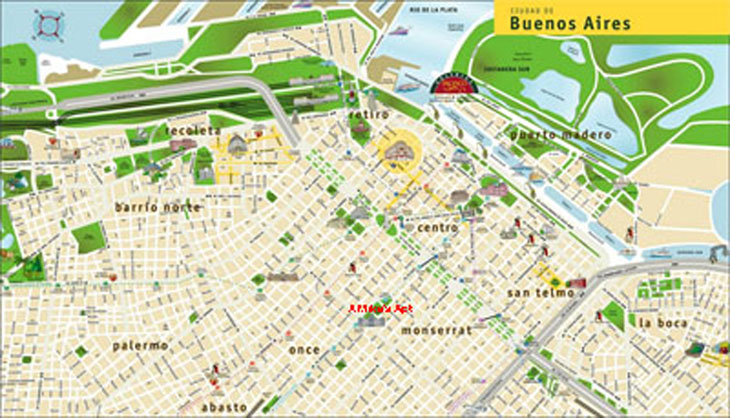 |
The Federal District of Buenos Aries (the Red X Marks Mike's Apartment) |
The first thing I did was line up two tours, actually three. The first tour was a combination trip that offered a bus trip around the city in the morning followed by a longer bus trip up to La Tigre, a town about 40 kilometers north of BA. The La Tigre tour included a one hour catamaran trip along the Rio Lujan, one of the tributaries of the Paraná River that feeds the Rio de la Plata delta. Both of these quite different tours worked out very well as described below. The third tour would be a full day excursion to Montevideo, Uruguay across the Rio de la Plata (to be reported on next month).
Combo Tour
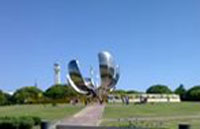 |
Floralis Genetica Monument |
In the morning of the first tour I was picked up promptly at 8:45 in front of the Hotel Savoy, the entrance of which is just 20 meters or so from the apartment building where I was staying in downtown Buenos Aires. After several more stops at hotels we proceeded to the northeast side of the city. During a brief stop at the University of Buenos Aries Law School I took a picture of the flower monument (Floralis Genética) next to the campus. This huge, striking stainless steel flower opens during the day and closes at night and is a national monument to all the flowers of Buenos Aires and the provinces.
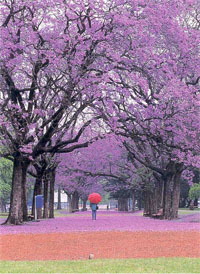 |
Jacarandas in Bloom |
And there were flowers. As it was spring in Buenos Aires, the Jacaranda trees were all in full bloom with their dark blue-purplish flowers crowning many trees along our route. This is a tree that GG had become familiar with in Florida except that in the Sunshine State they bloom in late February or early March right after the brilliant yellow Trees of Gold have finished signaling the entrance of the spring season. Another difference with the Buenos Aries Jacarandas is that they have been planted on many avenues and streets and are in fact prolific throughout the city.
The next part of the tour took us through the Palermo district, regarded as the most affluent neighborhood of the BA federal district. It is an area not only of expensive private homes but also of many embassies, beautiful parks and impressive monuments, many of which have been donated by other countries over the years as gestures of friendship. Monuments abound in virtually every part of the Buenos Aires federal district.
La Boca and GG the Coach
After Palermo, we wandered back towards the centro district driving on two of the best known avenues in the city, Avenida 9 de Julio and Avenida de Mayo. We passed by the National Congress building and on to an area called La Boca. This area is a poorer district than many of the others but also is rabid futbol country and has become famous to tourists and visitors for its colorfully painted neighborhoods.
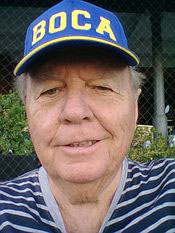 |
This is Why Old People Shouldn't Take Selfies |
GG had purchased a gorra (baseball cap) the first day wandering around BA with Mike when I realized that I had forgotten to pack one of the six I have at home (ya have to forget something on a trip, don´t ya?). At first I interpreted the word on my new hat, “BOCA”, as “snack”, like the way we often use the word in Costa Rica but the sales clerk told me that BOCA here is the name of a well known local futbol team.
The other team he mentioned was River Plate; that one I had heard of before. I surmised that the River/BOCA rivalry was sort of like the Saprissa/La Liga thing in Costa Rica. A local gent in the Centro area later told me (proudly) that River was in the lead to be regional champs this year but BOCA was only running in fourth place. Unfortunately for BOCA, the great rivalry between the two teams included a game during my visit on November 27, which was U.S. Thanksgiving Day and my birthday. River Plate prevailed 1-0. It wasn´t easy wearing my BOCA cap for the next couple of days.
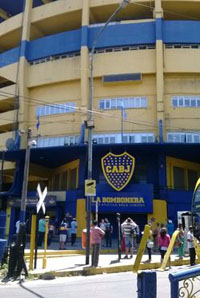 |
BOCA Stadium |
So I had my hat on when we visited the La Boca area and I just kept getting thumbs up signs from the local populace. It was apparent that we were in BOCA country as we stopped near the local stadium (photo right). The acronym CABJ on the stadium and various paraphernalia stands for Club Atletico Boca Juniors, the official name of the BOCA team.
The stadium is formerly and officially known as Estadio Alberto J. Armando (sorry, I didn't ask who Al was) and affectionately known as La Bombonera. If I remember correctly, the stadium seats about 49,000 but once had an attendance of over 57,000 for a FIFA World Cup game some decades ago. La Bombonera is one of a half dozen or so futbol stadiums in the BA area. Buenos Aries, of course, is also the home of the world´s best paid futbol player, Lionel Messi, who actually plays regularly for Barcelona but also plays on the Argentine National Team for international events like the world cup. Futbol is taken very seriously here, amigos.
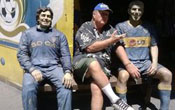 |
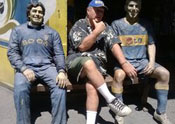 |
GG Giving a Few Futbol Pointers to the Locals |
While in La Boca, GG generously offered his prowess as a futbol coach, six years in the making and derived from watching the dudes of barrio Los Angeles play at the indoor futbol arena in Quepos . You know, sharing passing strategies and pointers on how to cause a severe curve on a goal kick that would completely fake out a portero (goalie).
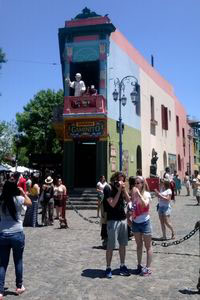 |
The Pope's Bar |
The boys on the bench (see photos left), assistant BOCA coaches all, seemed to appreciate the conversation and tips. (Actually, I´m told that they are likenesses of two famous former players; Diego Maradona left and Martin Palermo right). Maradona was considered to be like Pele and was involved in the 1986 World Cup win.
Also in the La Boca district is a famous area called El Camanito, or little walking street, where many of the houses have multi-colored facades. GG came across a corner bar in this area that has a replica of the pope giving a blessing, or at least saying "Hi", on the second floor balcony (remember that the current pope is from Argentina and was Archbishop of Buenos Aires before taking on the Curia in Vatican City). A picture of the Pope´s bar is at the right. Salud, amigos!
Tango City
Buenos Aries is known as the Tango City. Historically the tango is believed to have been invented as a raucous, sleazy and sexy dance in the city´s worst night clubs in the city's port neighborhoods, like La Boca, back in the late 1800´s/early 1900´s. Today tango is an institution in Buenos Aires; there are numerous shows and legitimate schools all over the city that specialize in this type of dance. And some versions of it now are more like ballroom dancing than sexy.
But, as GG found out walking around La Boca near the stadium, one doesn´t have to go to a nightclub to see a show or to a school to get involved with tango. Check out the pictures below. Why, would you believe this beautiful young girl walked right up to me, complete with an appropriate hat to lend me for the occasion, and asked if I wanted to learn the tango. How could I refuse?
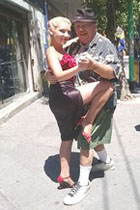 |
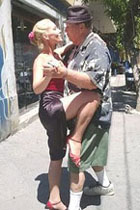 |
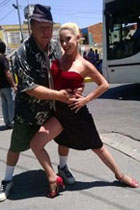 |
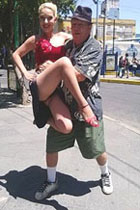 |
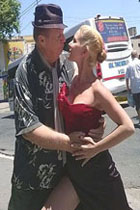 |
More Fun Than a Barrel of Monkeys - There's Life in the Old Dude Yet! |
||||
After the tour through La Boca, we were brought back to center city (the very center of Buenos Aires is often called “microcentro”) where we were released in front of the Sheraton hotel to wander around Avenida Florida and find our own lunch. Avenida Florida is a walking and shopping street with many types of shops, stores and restaurants so there was no trouble finding a lunch spot. Some days later I found one galleria there with some 15-20 stores devoted to computers and telecom only – I needed a memory stick to carry back all the pictures and notes from the trip (8 gigs - US$10).
I went to sit at a table for two at a corner restaurant but before I could sit, the waiter greeted me by saying, very seriously in English, “You can´t sit there.” I was taken aback at his seemingly sincere seriousness and asked “Why not?” With a dour face he said “Not with that hat, says he (the BOCA cap).” I started to feel irritated before I realized he was putting me on – then he broke out in laughter and we both laughed through lunch. At the end I suggested he consider acting as a career as he was damn good at it.
After lunch we boarded the bus once more and headed north, out through Palermo again and then along an expressway (autopista) that passed to the east of the other major Buenos Aires airport, Newbery. El Aeroparque Metropolitano Jorge Newbery (AEP) airport services domestic flights and bordering countries like Uruguay and Brazil. It was the original BA airport and is much closer to downtown than EZE.
After about a half hour we pulled into a railroad station in a park area in La Tigre where we could wander through shops once more (seems like tours are tradition-bound or maybe incentivized to expose tourists to a maximum of buying opportunities). Alternatively, one could explore an architecturally interesting cathedral that was nearby.
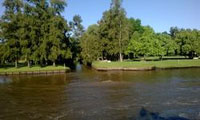 |
Riding on the Rio Lujan |
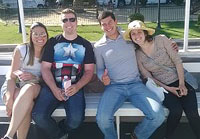 |
New Friends from Brazil & Uruguay |
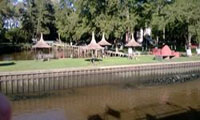 |
Boat House on Rio Lujan |
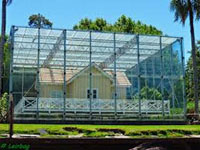 |
Sarmiento House Under Glass |
Next we took the bus farther into La Tigre. Our guide told us La Tigre gets its name from a specie of wildcat they call a jaguarito, or little jaguar, that used to populate this area; but the cat has since become extinct. The bus wandered up to a dock area where we boarded a catamaran for a one hour tour on the Rio Lujan . The Lujan is a tributary of the Paraná that helps make up the Rio de la Plata delta. It was a sunny day, pleasantly warm (24C/75F) with a mild breeze and the top deck of the catamaran offered a great view of both sides of the Rio Lujan. I learned that we were still as much as 10 km away from the open waters of the Rio de la Plata and would not reach it on this little jaunt but I would see it big time on the Montevideo excursion later.
Note the two couples in the photo to the right. We became friendly after meeting on the tour bus and my telling them that some people in my home town of Quepos call me Bob Esponja (Spongebob). These two couples hit it off with each other as well because of similar ages, interests etc. The couple on the left was from Brazil (São Paulo area); she spoke a little English, he none. The couple on the right were from central Uruguay and were two days married as of that picture; neither spoke English. My Spanglish sufficed, they were nice people all.
The guide pointed out that we were traversing the delta of the Rio de la Plata which consists of as many as 1,000 islands that were built up over the eons from the silt flowing into the Rio from the two major rivers that feed it; the Paraná and the Uruguay. The Paraná, our guide pointed out, is one of the longest rivers in the world and second in length in the Americas only to the Amazon. The Paraná runs almost 5,000 km or just over 3,000 miles from eastern Brazil to the western side, then through Paraguay and through much of Argentina before emptying into the delta.
The Lujan-La Tigre area is now a kind of summer lake district that provides an escape destination from the rigueur of the big city and/or political life. It was first championed as a recreational area by Domingo Faustino Sarmiento who, as the seventh president of Argentina in the mid’1800´s, built a home there. To commemorate him and preserve the house he built, it has been restored and enclosed in glass; see the photo to the right. Sarmiento is credited with “championing intelligent thought” (we could use more of that) and instituting universal education in Argentina.
We saw many villas, rich and modest along the banks of the Lujan as well as smaller creeks proceeding away from the main channel where private boat docks were prevalent. Many boat and rowing clubs also have facilities along this river and the area is frequently a site for rowing meets and championships. The guide told us that a strong southerly wind could produce up to six feet of surge in the river, which is why many of the homes are built on stilts, much like those found in the mid-Atlantic region of the U.S. northeast.
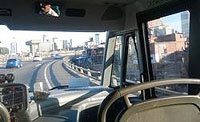 |
Our guide also pointed out that he believed the river waters there are pollution free. The color of the water, kind of a golden brown, is from the sediment or silt that washes down from the rivers. I did note the lack of hesitancy of locals to jump off their boat docks for a refreshing plunge, especially several small groups of young boys and girls who were having a ball. The slow current in the Lujan evidentally, at least on that day, does not present a hazard.
After the boat tour we returned to Buenos Aires by bus via the autopista and I snapped the photo to the left of the big city as we approached downtown. It was a great day and a great combo tour.
¡Solo Bueno!
Visiting Buenos Aires
(Part 3 - The Food)
GG had intended to write about the food and restaurants in Buenos Aires as part of the earlier narratives published last month and above but then realized there was too much to report. So here's a summary of three weeks of good eating experiences.
First Impressions
When we arrived at Mike's apartment on the first night he pointed out there was a MacDonald's on the same block and a Starbuck's on the next corner. Not haute cuisine, but I would not starve. On the contrary, as I got to know the area the problem became what restaurant to choose, from the half dozen or so there seemed to be on every block. I would come to see that there are a thousand ROMEO reviews possible in that town and surrounding area. Mike also mentioned a supermarket on the next block called Disco, a place I would learn to frequent for daily groceries.
But let's talk about the food of Buenos Aires by type.
Argentina enjoys a well-deserved reputation for excellent quality beef. Cattle were first brought to the country by the Spanish in the mid-16th century about the time of the founding of Buenos Aries (see A Brief History of Argentina (Part 2 - The Columbian Period, 1500 to 1816).
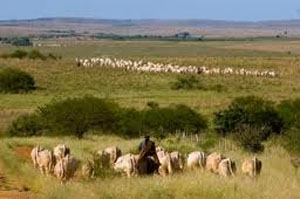 |
Gauchos Herding Cattle on the Pampas |
Some of the cattle were left behind to roam the Pampas southwest of BA, a land of fertile grasses ideal for free-range grazing. The story goes that the number of cattle grew quickly because of the rich grasses and the fact there was no market in the country for the beef at that time to deplete the herds.
That changed as time went on and ranching practices were introduced that put discipline into the raising of beef. It also became apparent, because of Argentina's southern hemisphere location, that the beef matured at different times than in the north and this gave rise to major export markets in North America and Europe that still exist today.
Because of the easy availability of quality beef (at a low price I might add), Argentines have never lost their taste for the various and numerous parts of a steer well cooked. There are literally hundreds of Parillas (a restaurant that specializes in grilling meat, a grill room) in the city, province and throughout the country. Many use a form of barbecuing called asado, where the meats are clamped between two large grates and quickly roasted over an open wooden fire. GG learned that Argentines like their asado medium to medium-well done but GG was also able to get a medium-rare steak after a little conversation.
One day GG spied a parilla about six blocks from the apartment called the Parilla Peña and two of us proceeded there that evening to try it out. My Argentine dinner companion suggested grilled mollejas (sweetbreads), then grilled costillas (ribs), then a churrasco (steak). All were done medium-well and were delicious. Dude, it doesn't get better than this (hold the comments on artery choking etc., one has to cheat occasionally). The bill for two people - less than $35.
Two days before returning to Costa Rica, three of us repeated this experience but this time at a Peruvian restaurant a few blocks from the Congresso. I placed my trust in the two Argentines and we had an excellent asado. Before the asado we had a ceviche, small pieces of whitefish pickled in a marinade, something the Peruvians are known for. I also learned about a special corn kernel that decorated the ceviche plate and is from Peru, a corn about three times the size of typical maize kernel, dry and crunchy (the waiter said it's actually fried). He called it mote - moh-tay. Outstanding. We split the $45 check three ways.
If you go to Buenos Aires or other parts of Argentina and don't try the beef and the parillas, you've cheated yourself. If you're vegetarian, sorry, perhaps in another life (or maybe try the Italian below).
Recall that many Italians emigrated to Argentina in the 1900's. The country is the better for it and the Italian influence, from pizza to pastas to incredible desserts, is prevalent throughout the city. Simple pizza places, that usually serve empanadas as well, dot the cityscape like soda-type restaurants do in Costa Rica.
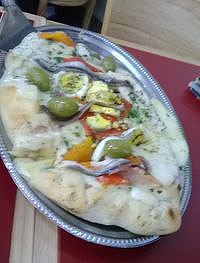 |
Calzone from La Americana |
On one of the first days there, Mike introduced me to a place, conveniently located one block away from the apartment, called La Americana. which billed itself as "La Reina de Empanada" or the Queen of Empanadas. The empanadas were excellent but the pizza, oh my, the pizza. That first day we had a medium sized pie with thick crust that was golden and crispy on the bottom, oozing with enough fresh muzzarella to plug a small dyke and topped simply with thinly sliced tomatoes and onions, then dotted with large un-pitted Spanish olives and lightly dusted with basil flakes.
Without doubt, it was the best pizza I've had in 30 years. I went back there three more times over the three week visit. Check out the fully loaded calzone including sardines and hard boiled egg (photo right) that ended up being three lunches for the golden one. Que bellisimo!
And then there was the Sorrento, a restaurant located in Puerto Madero, the dock area where Mike first had taken me. I went back to Puerto Madero alone a couple of weeks later and, walking along the waterfront, I saw a posted "prix fixe" for a three course lunch for $250 (that's 250 pesos or about $18). There were several options for each course and I selected 1) jamón Serrano (best damn ham in the world and I hadn't had it since the 1970's in Spain) with crudités, 2) black ravioli (colored by truffles?) stuffed with minced salmon and gently covered with a light sauce of olive oil, a touch of pimento and some lemon grass and 3) an open apple/apricot tart with a dollop of apricot ice cream and drizzled with chocolate and raspberry sauces.
Does it get better than this, amigos? Where, pray tell GG, I want to go there?
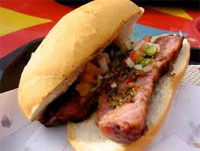 |
Choripan |
Before going to Buenos Aires, several Ticos strongly suggested I try choripan. What is choripan says I? A sausage (chorizo) on a bread roll (pan) was the response. I thought, yeah OK, but I'm not going to a great city like BA to try a hot dog. Pray for forgiveness, oh Golden One, this is not a hot dog, it's a culinary adventure.
Take a large, mildly spicy Italian sausage, split it lengthwise, grill it crisp on both sides and insert it into a hard-topped Italian roll. Have a self-service table available and filled with a dozen condiments including chopped onions and sweet pepper, cole slaw, and chimichurri (the green kind made from finely chopped basil, parsley and olive oil - not the tomato based version found in Costa Rica). Load the sucker up until it oozes over your fingers. What yummy finger food!
This concoction should be required by law at every sports event and outdoor activity.
Cafe Tortoni
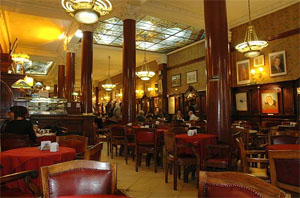 |
Cafe Tortoni in Buenos Aires |
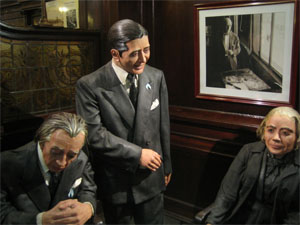 |
The Current Collection of Intellectuals is a Little Stiff |
This coffeehouse/brasserie is one of the best known restaurants in Buenos Aires, or in the world for that matter. It was named Tortoni after a cafe in Paris of the same name that was known as an early 20th century gathering place for Parisian gentry and artists on the Boulevard des Italiens.
The Buenos Aires version has been visited by an endless steam of artists, writers and famous personalities like Albert Einstein, Federico García Lorca (famous 20th century Spanish poet), Hillary Clinton, Robert Duvall, Juan Carlos de Borbón (the King of Spain), the Golden Gringo, and many others. Although originally opened in another location, it moved to the 800 block of Avenue de Mayo (about eight blocks east of the Congresso) in 1880. It was constructed by a Frenchman.
In the basement is a small nightclub where they have Tango shows and which is often home to jazz ensembles as well as book and poetry presentations. The section in back of the restaurant on the main floor also has a library and facilities to play billiards, dominoes and dice.
The motif at the Tortoni is striking and reflects designs prevalent in the late 1800's. Very warm in its use of woods and indirect lighting plus several overhead skylights with intricate patterns in stained glass (see photo above, left). The tables are simple and the wait staff has that classic brasserie look, dressed in black and white with almost ankle length black aprons. I sat in the back of the dining room across from a table that had three rather stiff individuals (see photo above). It turns out these mannequins represent well known BA resident artists in the past (Jorge Luis Borges, Carlos Gardel y Alfonsina Storni) who frequented the Tortoni and used that particular table.
As far as the food goes, the luncheon sandwich special I had was good but not outstanding. For my money, La Americana is just as good if not better, but one doesn't go to the Tortoni necessarily for the food but more to say you've been there and felt the historical vibes, which are strong.
American Club
The last week I was in Buenos Aires happened to include U.S. Thanksgiving on November 27 which also coincidentally was my 71st birthday. I decided long about Monday of that week that it would be nice to have a traditional Thanksgiving meal as well as treat myself for the birthday.
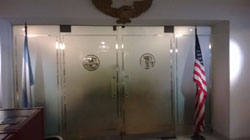 |
Entrance to the American Club of Buenos Aires |
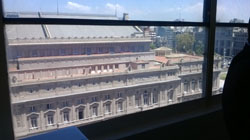 |
Teatro Colón from American Club |
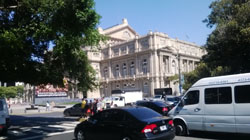 |
Teatro Colón at Street Level |
As I found out, Thanksgiving is not widely celebrated in Buenos Aires and a Google search turned up only one meaningful hit; there would be a Thanksgiving luncheon at the American Club of Buenos Aires (later I learned the official title of the organization is the American Society of the Rio de la Plata). Promised were turkey, ham and all the trimmings plus wine and beer - $160 (pesos - US$12). Cash bar at Noon, Lunch beginning at 1 PM. I sent them an email on Monday to ask if a reservation was needed - I never got a response.
I found out that the American Club was located on the 10th floor of a building in the 1100 block of Avenida Viamonte, quite a long walk from the apartment but I decided to "take the air" that day nevertheless. Never one to be shy, and not interested in the cash bar, I showed up at 12:30 only to find that the two hosts who were processing the attendees couldn't speak English.
The hosts were dismayed that I didn't have a reservation. A quiet, diplomatic discussion ensued among the three of us, with them repeatedly saying all the people had reservations. I just continued to talk (isn't that what diplomats are supposed to do?) as best I could until the lady finally said: "Why don't you sit over there and we'll see what we can do."
So I sat in the foyer watching an endless stream of aging diplomats in suits and formal dresses parade into the dining room after paying their 160 pesos. I had two thoughts as I waited: 1) I was grossly under-dressed without jacket or suit even though I had long pants, dress shoes and socks on, and 2) on my 71st birthday I was still younger than half of them. Most of the people were speaking Spanish as a native language and I came to believe this "American" club probably is composed of many native Argentines who had diplomatic or business contact over the years or maybe hold dual citizenship.
I honestly thought I was going to be politely told their was no room for me, but at about 1:20 the lady said, "You can go in now." After paying my fee of $250 pesos (I was not a member in good or any other standing so I had to pay a higher entrance fee) I was shown a table at the far corner of the room from the dais where I took a seat. Our table was located on a balcony beyond a glass partition that separated it from the main dining room. We were definitely in the overflow group. Our view included looking down on the Teatro Colón, probably the best known theater in Buenos Aries and which had been suggested for an inside tour (next visit). By my count there were 110-120 people in the room dispersed eight to a table, except we had seven at my table (I should have brought a date).
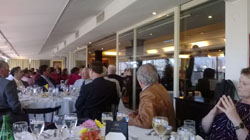 |
From GG's Table at American Club |
My dining partners included a man (Ernie) who owned a bi-lingual school named St. Paul's and his lady guest who was also the headmistress of the school., a second and very elderly couple (87-89) who had lived in the States for years where he had been a commercial attaché at the Argentine Embassy there and to my left, the Pubic Relations Agent for the American Society of the Rio de la Plata, accompanied by his assistant.
Over the course of the lunch and presentations I learned Ernie had lived in Costa Rica ten years (1959-69) and the school marm had grown up in Rowley, Massachusetts, a small town 15 miles from where the Golden Gringo grew up. After establishing those facts the conversation flowed easily. The retired diplomat and his wife, as well as the PR couple, were all very friendly and tolerated GG's Spanglish.
The luncheon was a great; turkey, stuffing and trimmings as well as pumpkin pie with whipped cream. The event was also a meaningful conclusion to a wonderful three week adventure in Tango City. I will always be an American, even when I'm a Costa Rican resident visiting another country but I am thankful for having had the opportunity to have been able to visit such an interesting and beautiful city.
Next month: One more story from this trip - visiting Montevideo, Uruguay.
Travel Quote of The Month |
“People don’t take trips – trips take people.” John Steinbeck |
What's-in-a-Word
Criollo
Adjective, masculine - criollo, feminine - criolla; meaning native of or born in Latin America, particularly South America. Also, creole in food or language.
Tango
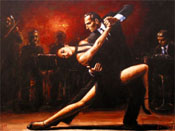 |
The word “Tango” is believed to have origins in Africa (originally the name of an African-American drum dance, probably from a Niger-Congo language). There are records that say the dance was embraced in Cuba and Spain and may have been a variation or melding of Flamenco movements.
After that, tango fever peaked first in Paris in the 1910´s, followed by other European capitals like London and Berlin as well as New York. Because of the body contact, the dance was considered “shocking”, sort of like a 1900 version of Dirty Dancing. And it takes two to do it, amigos.
Gorra
 |
Spanish, commonly used today for a baseball cap (also for a baby's bonnet).
Some of the types of gorras and sayings used with them:
gorra de montar - riding hat
gorra de paño - cloth cap
gorra de punto - knitted cap
gorra de yate - yachting cap
pasar la gorra - to pass the hat round
pegar la gorra - to be unfaithful
Feminine noun. In mainline Spanish, it means trouble, worry (preoccupación); (pena) grief; affliction; (civil, doméstico) strife; contar sus cuitas a alguin (to tell one's troubles to someone). In Central America, it also refers to poultry manure or dung, giving rise to Manuel Antonio's Lorocuitas Island as Parrot Dung Island (just reporting, I don't make this stuff up).
ROMEO Corner
(Retired Old Men Eating Out)
El Lirio, Manuel Antonio
Location: From Quepos, head to the top of Manuel Antonio, Villas Lirio Hotel is just 50 meters
before the MA football field on
the left.
Hours: Breakfast, Lunch and Dinner Monday through Sunday.
Parking: Some, inside the hotel compound.
Contact: Tel.: 2777-1182; Email: ; Website: http://www.bwvillaslirio.com/
Reviewing ROMEOS: Anita M., Bob B., Bob N.
To Review Our Rating System and Procedure, go here: R.O.M.E.O. Rating System
We were surprised by this one, or at least GG was. The restaurant is part of the Best Western Villas Lirio hotel in Manuel Antonio. The entrance to the hotel is rather subdued and nondescript with no signs indicating a restaurant lies within. GG had passed this spot a thousand times and never knew the restaurant existed. I had attended a Chamber of Commerce function there some years ago but the room (lower level) seemed like a dungeon. I was wary of what we might find.
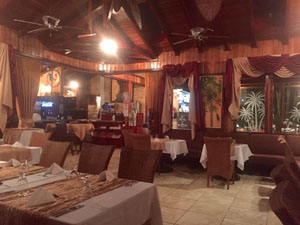 |
Main Dining Room - El Lirio Restaurant |
It turns out that the main restaurant is located on the upper level and accessed by a long winding path that passes through a jungle-like wooded area. The restaurant is situated in a large wooded area and, although the main entrance to the dining room is open to the woods, the room itself is enclosed by tall etched-glass windows that look out onto the jungle which is backlit in places for effect at night.
The dining room itself is situated in such a way that there are three distinct sections providing for a certain degree of privacy for intimate conversation. The room is decorated with a large amount of off-white and burgundy valences, gentle indirect lighting, table cloths with runners and padded chairs. Indeed this is a very pleasant, warm and comfortable dining room and we all quickly agreed on a five sloth rating for atmosphere.
GG started with an appetizer that was described in the menu as grilled vegetables, yet what arrived was a tower of food that had a slice of grilled pineapple topped with successive layers of eggplant, grilled un-breaded onion rings, mushroom slices and raw bean sprouts. The size of it would have made a good lunch by itself.
The menu offered a fairly broad selection of fish (special that night was Mahi-Mahi), salads, meat dishes and pasta. GG spotted a pork tenderloin offering that promised a blackberry sauce concoction (see photo left) and two of us ordered that. The other ROMEO took a chicken milanese over linguini dish. Both were pronounced excellent. The quantities provided in each dish were more than ample and GG took half the pork dish home in a monkey bag (kind of like a doggy bag but more suitable for the rainforest) to be used as a lunch the coming week. For dessert GG ordered what was billed as a lemon pie that was basically a lime custard with a sweet bottom crust and drizzled with a lime sauce. Very good. We give El Lirio five sloths for food quality. |
 |
|
|---|---|---|
$$$$1/2 Value Index = 111 |
||
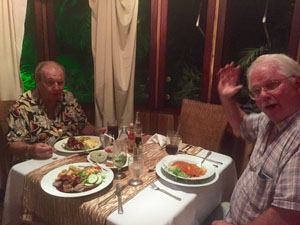 |
A Couple of ROMEOs Enjoying El Lirio |
Our waiter was friendly, courteous and helpful. He only fell short on one minor item, as he failed to deliver a cup of coffee that was ordered with dessert. We gave El Lirio four sloths for service. That still results in an overall rating of five sloths (our top rating) for atmosphere, quality and service.
We found the restaurant to be fully priced in comparison to other local emporiums. Two of the ROMEOs had bills in the 15,000 colone range ($25-30) and GG's three course extravaganza was billed in a slightly over 20,000 colones (about $37). That puts the restaurant in the top 10-15 per cent cost-wise for this area and gives it a cost rating of $4.5. In turn that gives the restaurant a Value Index of 5/4.5x100=111, which is in the lower part of the top half of restaurants we have reviewed in the area.
For a good meal in a pleasant atmosphere, yet fully priced, we can easily recommend restaurant El Lirio at the Hotel Villas Lirio.
¡Solo Bueno!
Golden Gringo Chronicles E-Books and Hard Copy Novel Now Available!
A narrative version of the Golden Gringo Chronicles is now available as a trilogy of E-books in formats compatible with virtually all electronic platforms. Click on Part Number above for E-book sample downloads or click the price above right for purchase. (The best price is on Part 1; it's FREE)
The story of the Golden Gringo Chronicles is also available as a hard copy novel of 192 pages available through Amazon and all major online retailers. ($9.95) Amazon link: GGC, the Book. (Kindle Edition available) Follow GG through the first six years of his odyssey in making the decision to retire in Costa Rica, overcoming the trials and tribulations of moving and obtaining residency there and the fun and experience of actually living in Ticoland. Ride along with the Golden Gringo as he learns about the rich, varied culture of Costa Rica, the incredible bio diversity, the charming nature of the Costa Rican people and the ease with which a sometimes clueless ex-pat can assimilate into a small southwestern town on the Pacific coast. Whether you are already a Costa Rican resident, someone contemplating a move here or just a traveler who enjoys different cultures, you will find the Golden Gringo Chronicles interesting, entertaining and informative about Costa Rica. |
don Beto de Quepos,
El Gringo Dorado Pura Vida! |
Be pithy but kind; I'm sensitive. |
|---|










